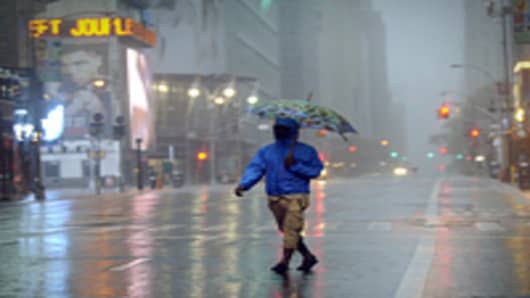Hurricane Irene had long since passed, but a lot of people who were hoping to get on airplanes as airports in the Northeast reopened Monday were not going anywhere anytime soon.
The airlines canceled more than 10,000 flights over the weekend at the height of the storm and canceled at least 2,000 more on Monday as they struggled to return to normal. Their immediate concern was getting their aircraft and flight crews back into position. But the larger issue was the unforgiving arithmetic of modern air travel — most airplanes are flying nearly full, with little room to accommodate hundreds of thousands of turned away passengers, especially at a peak travel period like the week leading into Labor Day weekend.
The result was scenes like the one on Monday at Terminal 4 at Kennedy International Airport in New York, where suitcases were piled like barricades against walls, lines stretched out the doors and every available seat was claimed.
In the midst of it all were two young Ukrainian women, Olya Ponomarova, 21, and Julia Baran, 23, who had spent the summer working in the laundry room of a New York camp and were originally scheduled to fly home on Saturday and still do not know when they will get out. “We didn’t have any money on us, and now we’re stuck for three days already,” Ms. Ponomarova said. “We took showers in the bathroom sink.”
The disruptions rippled out from the Northeast. In Los Angeles, Jonathan Strauss, 46, a lawyer, said he had finished up a vacation with his wife and two children, and tried to head back to New York on Saturday night but their flight was canceled.
He tried again on Sunday, and was back again on Monday. He is now hoping to get home by Thursday.
“They wouldn’t pick up the phones,” Mr. Strauss said. “So yesterday afternoon I came to the airport for the first time, and there was a four-hour wait just to speak to anyone. So I said, you know what, let me go back and enjoy the great California weather. I went back, enjoyed myself, had a few margaritas, and came back again now to try to rebook.”
Late last week, while passengers all over the country with tickets in hand for weekend trips watched ominous reports of the approaching hurricane, most airlines had not yet decided whether to impose pre-emptive flight cancellations. With the exception of JetBlue, which announced 900 flight cancellations early Friday, major airlines held off scrubbing large numbers of flights until the Port Authority of New York and New Jersey ordered the New York area airports closed starting on Saturday.
“I think airlines played chicken with this hurricane,” said Joe Brancatelli, who publishes a subscription Web site for business travelers, Joesentme.com.
On the other hand, airline operations managers were in a difficult position. Airlines worry far more about wind or ice than rain, even torrential rain. So when they saw that the hurricane winds had diminished on Friday, they had reason to wait.
“I think a lot of the airlines waited for the Port Authority to force their hand before making major cancellations,” said Robert W. Mann Jr., an airline industry analyst and a former executive with major airlines.
“I think they consciously flew longer than they otherwise would have because they realized they will never be able to re-accommodate some of these customers in any kind of a relevant time frame,” he said.
Many of those customers had booked nonrefundable tickets for trips revolving around the holiday weekend. So their plans were upended even if they rebooked without having to pay a change fee, which the airlines are waiving, though with restrictions, for those whose travels were disrupted by the storm. The question for them is when they will be able to be accommodated.
Meanwhile, flying airplanes back to the right airports, and flying them out again on schedule, was only one of the major challenges. Getting vast complexes like airports back into operation after major disruptions was another one.
Like airlines, airports require thousands of workers to operate. In New York, where many airport workers depend on public transportation, resuming service was complicated by the fact that mass transit in New York was only slowly getting back on line on Monday.
“The primary concern is making sure that you have the number of people necessary to ensure the safe and efficient operation of the airport,” said Debby McElroy, the executive vice president of Airports Council International North America, the airport industry trade group. “Number two is working with the airlines to get a sense of what they predict will be necessary to accommodate passengers whose trips have been disrupted.”
“It comes down to basic logistics,” she said. “You also have to look at your staffing, your parking, all of your ground transportation,” and whether the Transportation Security Administration was “able to get enough people in to handle the crowds.”
Getting information from the airlines has also been a challenge for many passengers who are furious about interminable waits on customer service lines, and what many have said was a lack of reliable information on airline Web sites.
Mr. Brancatelli said he was swamped over the weekend with calls from passengers who were angry and frustrated about not being able to anticipate the extent of the travel disruptions, and then not being able to get through to airlines to make alternate plans.
One reason for that difficulty is the sharp reductions in airline staff, including customer service staff, even as airlines continue to cut flights and seat capacity to operate more efficiently. Airlines in the United States had 474,000 full-time employees in June, compared with 637,000 in June 2001, according to statistics from the federal Transportation Department.
Kennedy’s Terminal 4, meanwhile, was so crowded Monday afternoon that merely walking through the throng was difficult. Sabine Matthes, 28, a financial controller delayed since Saturday while trying to get home to Germany, said that she and a group of companions were hoping to fly standby to Frankfurt after learning that they could not be rebooked on their regular tickets until Sept. 6.
“We’re tired. Exhausted. And a little gross because there’s no showers at the airport. The toilets are like a Third World country,” she said.
Reporting was contributed by Christine Hauser, Ann Farmer, Ian Lovett, Dan Frosch and Robbie Brown.




